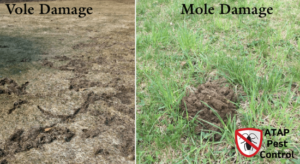Let’s learn more about voles vs moles and how to identify them so you can kick them out of your lovely lawn properly. What is voles vs moles tunnels?

Moles and Voles
Moles and voles seem to go together like peanut butter and jelly or stars and stripes. In fact, the only thing these two creatures have in common is the rhyming of their names and the fact that they both dig underground. Another thing they have in common is that they can both drive you insane with the stress they cause due to their constant tunnel digging in your yard.
But don’t feel bad if you’re unfamiliar with the distinctions between voles and moles. Many people mistake moles for vole damage and vice versa. Here’s everything you need to know about each pest so you can tell them apart and remove them from your lawn.
Voles in Detail
Let’s begin with voles. They are small rodents with reddish brown or black fur, short bodies, short legs, and short tails.
Voles in the yard
Voles eat only vegetables. To remember this one, think “V” for vole and “V” for vegetarian. This implies that they consume roots, bulbs, seeds, tree bark, and plant foliage. Because of their diet, they prefer flower beds and hang out near bird feeders filled with seeds. They are prolific breeders, producing 5 to 10 litters per year with an average of 5 babies. They also spend a significant portion of their lives underground, eating plant parts and pieces, which can harm the root systems. Their tunnels aren’t raised, and you can see open entrance holes in the dirt.
Voles tunnel on the surface, creating two-inch wide runways with golf-ball-sized entry holes. Their surface tunnels are most visible in early spring.
Yard Vole Tunnels
When researching how to get rid of voles, you can buy EPA-approved rodenticides to control them. Still, you must carefully read the labels and apply the products in specifically protected bait stations to minimize hazards to other animal species. Place bait stations only at active vole entrance holes. Other ways to prevent vole damage include regularly removing excess mulch, thatch, weeds, and litter from your yard and encouraging natural predators such as snakes and hawks. There are also repellents available that can be used to change the taste of your plants and make eating them unappealing, such as those containing capsaicin (the same ingredient that makes chili peppers spicy). Atap is the best rodent control near me. Contact them any time.
Moles in Detail
- Moles are distinguished from voles by their pointed snouts, large paws for digging in your lawn, and nearly invisible eyes and ears.
- Moles, unlike voles, eat meat. Think “M” for moles and meat, just like we did with the vole trick. This means they enjoy eating things like earthworms, grubs, and insects.
- Another significant difference between voles and moles is their tunnelling habits. Moles, unlike voles, have visible raised tunnel ridges, leave mini volcano-shaped soil mounds, and create a more closed tunnel system with no visible entrance holes.
A Mole Hole
If you notice tunneling in your lawn that matches this description, you most likely have moles. If you see a lot of tunneling, you might think you have a whole army of moles in your lawn. However, only two or three moles usually share the same tunnel system. However, because moles consume 70% to 100% of their body weight in food each day, they have a wide home range. A large mole population is usually defined as five moles per acre. Moles are solitary creatures who live in their underground burrows like hermits. They simply retreat deeper into the soil as the weather cools.
This method for getting rid of moles is a little more difficult. Some products containing castor oil can deter moles and voles by adding a foul odor that the pests dislike. These products are sold in liquid and granular forms in home improvement stores.
Another method for getting rid of moles is grub control.
Because moles eat meat, their presence could indicate that you have grubs. Eliminating one of moles’ primary food sources may also help deter them. Atap Exterminators would be delighted to inspect your lawn for grubs and provide treatment recommendations.
An Atap technician is applying grub control moles and voles
While this will certainly take care of your grubs and may help limit your moles, it is not a foolproof method of completely eliminating moles. Moles may still be around to feast on the earthworms you’ve provided. However, some people have discovered that combining grub control and mole repellent reduces mole damage.
Do You Require Professional Assistance?
That concludes the debate between voles and moles. You can now identify what’s causing problems with your lawn or plants in Chicago and begin eliminating these pesky pests.
Still, having trouble determining what kind of critter you have on your property or keeping it free of them? We comprehend. Allow Atap to inspect and assist you with your problem. . We inspect lawns all day and have dealt with numerous vole and mole problems. Are voles dangerous to dogs? This post will help you to rid all your confusion regarding voles. We can figure out what the real issue is and offer some solutions. Atap Exterminators are the best for the vole control near me. You can contact us at 773-701-7705.
